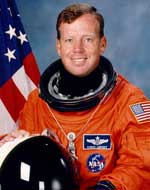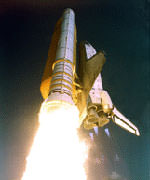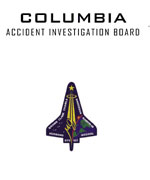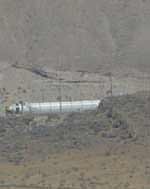NASA is planning to embed special sensors into the wings of the space shuttle fleet that will detect when they’ve been damaged – it was a foam strike like this that led to the destruction of Columbia nearly a year ago. A member of the safety oversight panel said that the sensors would be able to detect a hit, but not the extent of the damage, so astronauts would still need to spacewalk outside the shuttle to inspect it. Installing these sensors isn’t a requirement for the shuttle’s return to flight, but NASA believes it can have the work done by September 2004 – when the first shuttle is expected to lift off again.
Astronauts Announced for STS-121

Image credit: NASA
NASA has announced four astronauts who will launch on the space shuttle for mission STS-121; the mission after the shuttle returns to flight in late 2004. STS-121 was added to the schedule to help take over some of the tasks that were originally required on the Return to Flight mission. Commander Steven W. Lindsey, pilot Mark E. Kelly and mission specialists Carlos I. Noriega and Michael E. Fossum will be joined by three more unnamed crew members. They will re-supply the International Space Station and continue testing new hardware developed as part of the return to flight process.
Four NASA astronauts have been chosen to fly on the newly created Space Shuttle mission, STS-121. It is the mission following the Space Shuttle’s Return to Flight.
Veteran astronaut Steven W. Lindsey (Col., USAF) is the commander of STS-121. Mark E. Kelly (Cmdr., USN) is the pilot; Carlos I. Noriega (Lt. Col., USMC, Ret.) and Michael E. Fossum are the mission specialists. Other crewmembers will be named later.
STS-121 was added to the flight schedule to help accommodate the growing list of requirements originally assigned to the Return to Flight mission. The crew will re-supply the International Space Station with equipment and consumables. They will also continue the testing and development of new hardware and procedures designed to make Space Shuttle flight safer.
The crew recently began their pre-mission training together at NASA’s Johnson Space Center, Houston. Initial activities focus on general procedural training on Shuttle and Station systems, preliminary spacewalk development and robotics training.
Lindsey is a three-time Shuttle astronaut, including commanding the STS-104 mission in 2001. Kelly has flown in space once, and Noriega twice. Fossum is making his first trip.
For crew biographies visit:
For information about NASA and the human space flight program on the Internet, visit:
Original Source: NASA News Release
Shuttle Improvements Set to Cost $280 Million
NASA has estimated that implementing the improvements to the space shuttle fleet suggested by the Columbia Accident Investigation Board will set the agency back $280 million USD. One problem that NASA still hasn’t found the solution for is how to give astronauts the ability to repair holes in the wing, like the one that brought down Columbia. The agency is soliciting suggestions from outside as well; since November 12, they’ve received 286 suggestions – mostly from the public.
Three New Astronauts Added For Next Shuttle Mission

Image credit: NASA
NASA announced that three additional astronauts will fly into space aboard the space shuttle when it returns to flight some time after September 2004. STS-114 will consist of Mission Commander Eileen Collins, Pilot James Kelly, and Mission Specialists Stephen Robinson, Soichi Noguchi, Andrew Thomas, Wendy Lawrence and Charles Camarda. The mission objectives for the flight will be to test the new safety procedures developed as part of the Columbia accident investigation including shuttle inspection and repair techniques.
The STS-114 crew, augmented by three new members, is in place for the Space Shuttle’s Return to Flight mission. Three Mission Specialists have been added to the four astronauts already in training for the STS-114 mission planned for launch no earlier than September 2004.
The new crewmembers, Andrew Thomas (Ph.D.), Wendy Lawrence (Capt., USN) and Charles Camarda (Ph.D.) join mission commander Eileen Collins (Col., USAF), Pilot James Kelly (Lt. Col., USAF), Mission Specialists Stephen Robinson (Ph.D) and Soichi Noguchi, of the Japan Aerospace Exploration Agency, who were named to this flight in 2001.
“STS-114 is going to be a complex developmental test flight, and this crew has the right set of skills and experience to help get the Space Shuttles safely flying again,” said NASA’s Associate Administrator for Space Flight William Readdy. “STS-114 was always slated to have a crew of seven. But now, instead of three crew rotating on-and-off the International Space Station, all crew members will be dedicated to the STS-114 mission objectives,” Readdy said.
The major mission objectives of the STS-114 flight have shifted from International Space Station logistics and crew rotation to testing and evaluating new procedures for flight safety. This includes Shuttle inspection and repair techniques. It also includes a smaller set of Space Station tasks from what was scheduled before the Shuttle Columbia accident in February.
“This is a demanding mission and the addition of Andy, Wendy and Charlie, to this already well-qualified crew, ensures they have all the skills necessary to meet the challenge of Return to Flight and the resumption of Space Shuttle support of the International Space Station,” said Bob Cabana, Director of Flight Crew Operations at NASA’s Johnson Space Center.
“Andy brings a wealth of experience in all areas of operations from his previous Shuttle flights and Mir space station mission. Wendy is a superb robotics operator with detailed knowledge of all the Shuttle systems. Charlie has been actively involved with the thermal protection system repair activities and has trained as a backup Space Station crewmember. He is thoroughly familiar with the systems on board the International Space Station,” Cabana said.
“When coupled with Eileen, Jim, Steve and Soichi, who were already trained to perform the assembly tasks on this mission, the full crew will have the expertise and crew time to accomplish all mission objectives,” Cabana said.
Collins served as pilot on STS-63 in 1995 and STS-84 in 1997. She flew as commander in 1999 on STS-93. Kelly piloted his first mission aboard STS-102 in 2001. Robinson was on STS-85 in 1997 and STS-95 in 1998. He served as a backup crewmember for Expedition 4. Thomas, a long-duration Russian Space Station Mir veteran, also served aboard STS-77 in 1996, STS-89 and 91 to and from the Mir in 1998, and STS-102 in 2001. Lawrence, another space veteran, brings experience from STS-67 in 1995, STS-86 in 1997, and STS-91 in 1998. Noguchi and Camarda, both selected as astronauts in 1996, will make their first flight to space on STS-114.
For biographical information about the STS-114 crew and other astronauts on the Internet, visit the NASA astronaut biography page at:
http://www.jsc.nasa.gov/Bios/
For more information about NASA’s Return to Flight efforts on the Internet, visit:
http://www.nasa.gov/news/highlights/returntoflight.html
Original Source: NASA News Release
Additional Columbia Documents Coming

Image credit: CAIB
The Columbia Accident Investigation Board announced on Friday that they will be releasing volumes II through VI of their analysis and recommendations. The documents can be downloaded will be available for download on Tuesday, and printed copies can be ordered through an official government printer. The new volumes contain appendices and supporting documentation for Volume I, which was released back in August, and is still considered their formal recommendations on the accident.
The Columbia Accident Investigation Board will release Vols. II-VI of the CAIB’s Final Report at 10 a.m. on Tuesday, Oct. 28, 2003 on its website, www.caib.us. All of the volumes can be downloaded from the website. These volumes contain appendices that provide the supporting documentation for the main text of the Final Report contained in Vol. I, which was released on Aug. 26, 2003.
These appendix materials were working documents. They contain a number of conclusions and proposed recommendations, several of which were adopted by the CAIB in Vol. I. The other conclusions and proposed recommendations drawn in Vols. II-VI do not necessarily reflect the views of the CAIB but are included for the record. When there is conflict, Vol. I takes precedence. It alone is the CAIB’s official statement.
Hard copies of Vols. I-VI are available through the Government Printing Office for a fee. Those copies can be ordered from the GPO’s website, www.gpo.gov.
There will be no press briefing about the release of Vols. II-VI.
Original Source: CAIB News Release
New Shuttle Solid Rocket Booster Tested

Image credit: Blake Goddard
Alliant Techsystems performed the first static test of a new five-segment solid rocket booster for the space shuttle. This new booster gives approximately 10% more thrust than the four-segment boosters that the shuttle currently flies with. If these new boosters are installed on the shuttle it would have a few benefits: the shuttle would have enough thrust to still reach orbit if its main engine fails, it won’t have to make an emergency landing; or it could be used to let the shuttle carry an additional 10,500 kg of cargo.
ATK (Alliant Techsystems, NYSE: ATK) yesterday successfully conducted the first static test firing of a five-segment Space Shuttle reusable solid rocket motor (RSRM).
The test conducted by ATK Thiokol Propulsion, Promontory, Utah, was part of an ongoing safety program to verify materials and manufacturing processes, by ground testing motors with specific test objectives. This five-segment motor, also considered a margin test motor, pushed various features of the motor to its limits so engineers could validate the safety margins of the four-segment motor currently used to launch Space Shuttles. The static firing was also a test designed to demonstrate the ability of the five-segment motor to perform at thrust levels in excess of 3.6 million pounds, approximately 10 percent greater than the four-segment motor.
?This test demonstrated ATK?s unique ability and expertise in the design and production of the RSRM,? said Jeff Foote, group vice president, Aerospace. ?It is yet another visible commitment by NASA and ATK to ensure the highest quality safety standards and mission success for future Space Shuttle flights.?
Foote said that in addition to validating safety margins by over-testing many RSRM attributes, the static firing also demonstrated the capability of the five-segment motor to increase Space Shuttle payload capacity by 23,000 pounds, or enable a safe abort to orbit in the event of loss of thrust from the main engines.
The five-segment motor generated an average thrust of 3.1 million pounds and burned for approximately 128 seconds. The current four-segment configuration generates an average 2.6 million pounds of thrust and burns for approximately 123 seconds. The new motor measures 12 feet in diameter and is 153.5 feet long ? 27.5 feet longer than the four-segment motor.
The static test allowed ATK to verify and validate numerous performance characteristics, processes, materials, components, and design changes that were incorporated into the five-segment RSRM. The test had 67 objectives and employed 633 instrumentation channels to collect data for evaluation. Preliminary results indicate that the motor met or exceeded all objectives.
The Space Shuttle RSRM is the largest solid rocket motor ever flown and the first designed for reuse. The reusability of the RSRM case and nozzle hardware is an important cost-saving factor for the nation’s space program. Each Space Shuttle launch currently requires the boost of two RSRMs. By the time the twin RSRMs have completed their task, the Space Shuttle orbiter has reached an altitude of 24 nautical miles and is traveling at a speed in excess of 3,000 miles per hour.
ATK Thiokol Propulsion is the world?s leading supplier of solid-propellant rocket motors. Products manufactured by the company include propulsion systems for the Delta, Pegasus?, Taurus?, Athena, Atlas, H-IIA, and Titan IV B expendable space launch vehicles, NASA?s Space Shuttle, the Trident II Fleet Ballistic Missile and the Minuteman III Intercontinental Ballistic Missile, and ground-based missile defense interceptors.
ATK is a $2.2 billion aerospace and defense company with strong positions in propulsion, composite structures, munitions, precision capabilities, and civil and sporting ammunition. The company, which is headquartered in Edina, Minn., employs approximately 12,200 people and has three business groups: Precision Systems, Aerospace, and Ammunition and Related Products. ATK news and information can be found on the Internet at www.atk.com.
Original Source: Alliant News Release
Chase Planes Could Let the Shuttle Launch at Night
NASA is considering sending two WB-57F research planes to chase the space shuttle when it launches at night to watch for trouble. Ground cameras can’t see the shuttle clearly at night because of the bright glow from the solid rocket boosters. NASA is also modernizing its current imaging systems, spending $3.2 million on new computers, software and cameras – they’re adding at least 11 new cameras at various places around the Kennedy Space Center.
NASA Working on a Solution to Repair Shuttles
NASA gave a progress update this week on how their safety improvements to the space shuttle are going. It turns out, a $.99 foam brush does the best job of applying a special patch material that the astronauts can use to repair the shuttle’s heat tiles. They’re also working on ways to get better photos of the shuttle as it launches – even at night; currently the shuttle’s exhaust is too bright at night to really see the vehicle well enough to spot problems. The space shuttle Atlantis will likely be the next to launch, some time in September 2004.
NASA Targeting September Shuttle Launch
NASA has set a target date of September 2004 for when the first space shuttle will launch since the Columbia disaster. The agency was originally targeting earlier in the year, but they felt they needed more time to develop tracking and repair systems to fulfill the safety requirements suggested by the Columbia accident investigation. The improvements include new camera systems to watch the shuttle launch, a way for the astronauts to repair damage while they’re in space, and modifications to the external fuel tank to prevent foam from hitting the shuttle in launch. The next shuttle to launch will likely be Atlantis.
Shuttle’s Return to Flight Pushed Back to Summer
The return to flight of the space shuttle will probably be pushed back to midsummer according to NASA officials; not March as they had originally anticipated. The delay is being caused by the complexity of implementing the safety recommendations of the Columbia accident investigation, which called for additional cameras, day launches, and redesigns to several shuttle components. When Atlantis finally does launch with only four astronauts, its only purpose will be to test out the new safety improvements. It will dock with the International Space Station and allow the astronauts to test methods for finding and repairing damage to the shuttle’s exterior.
